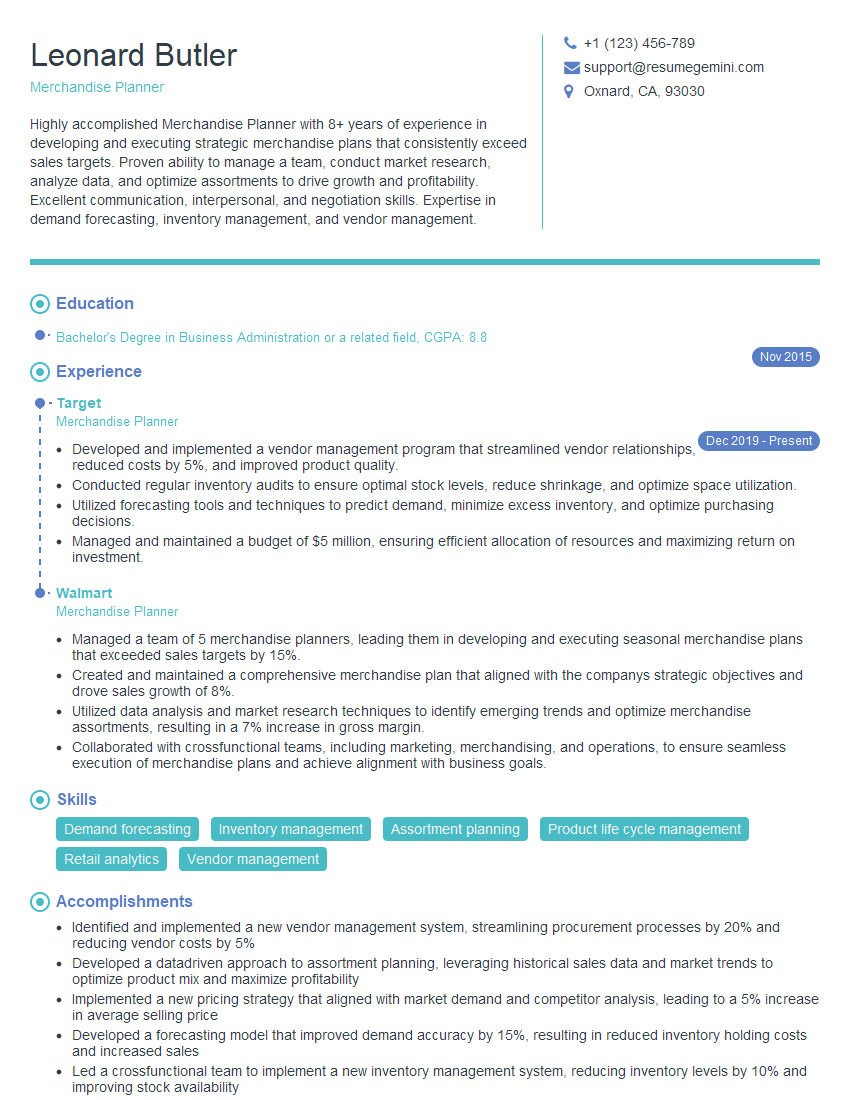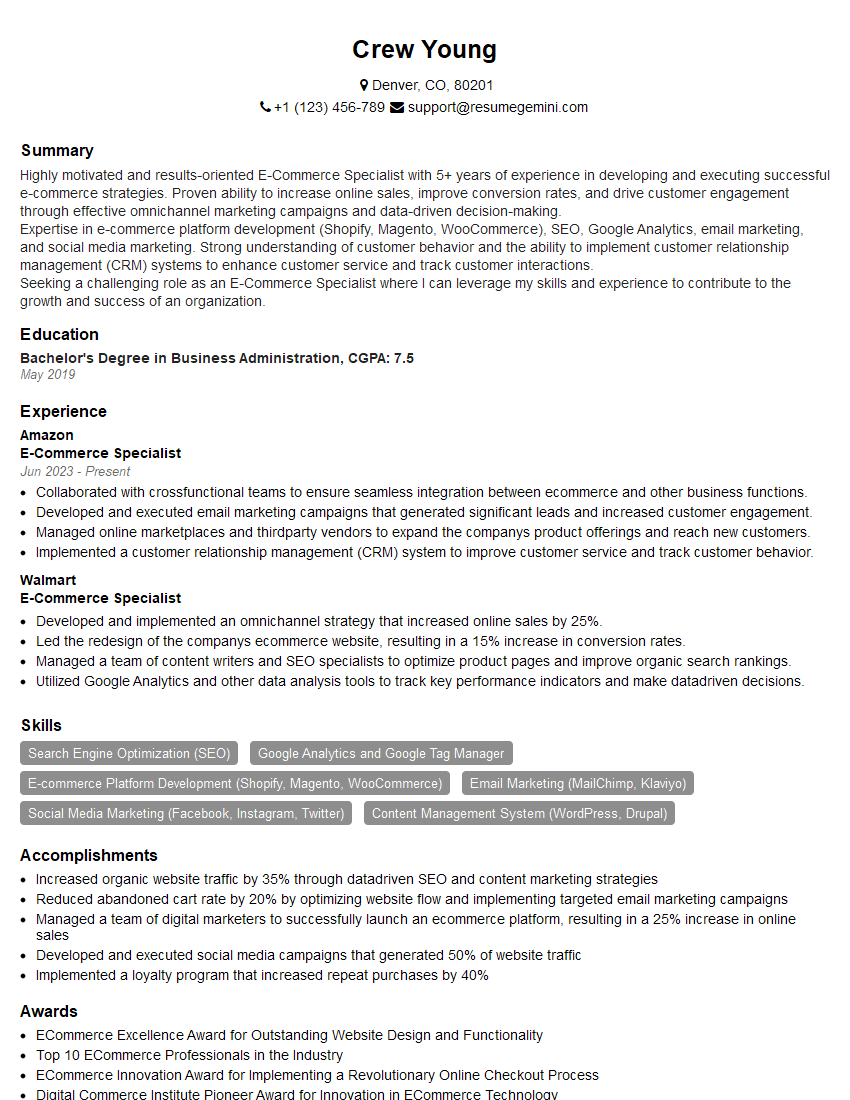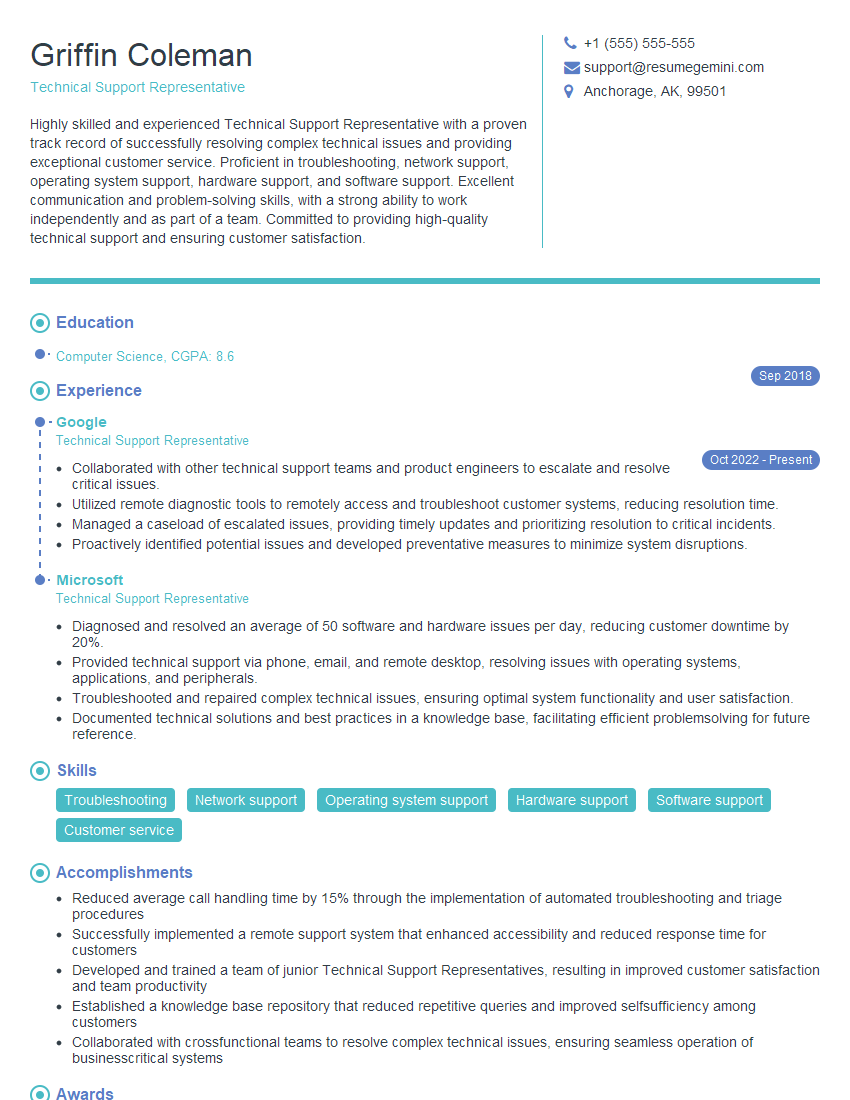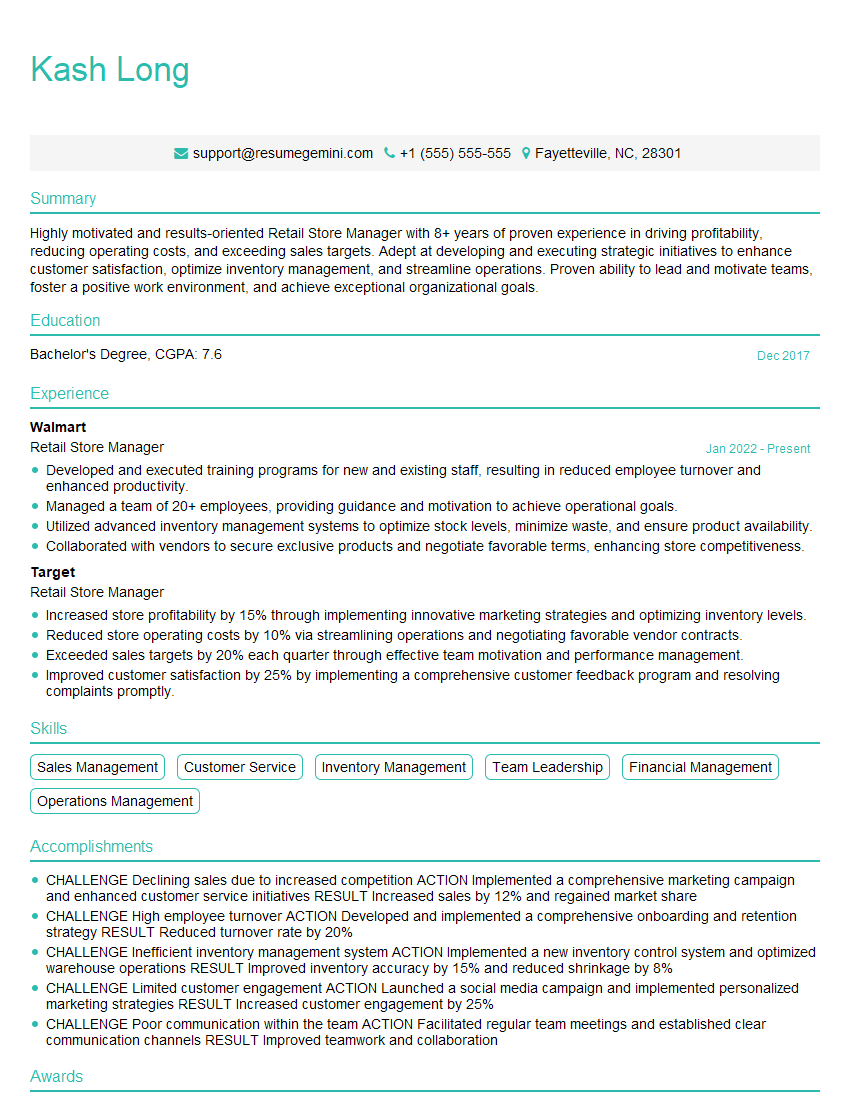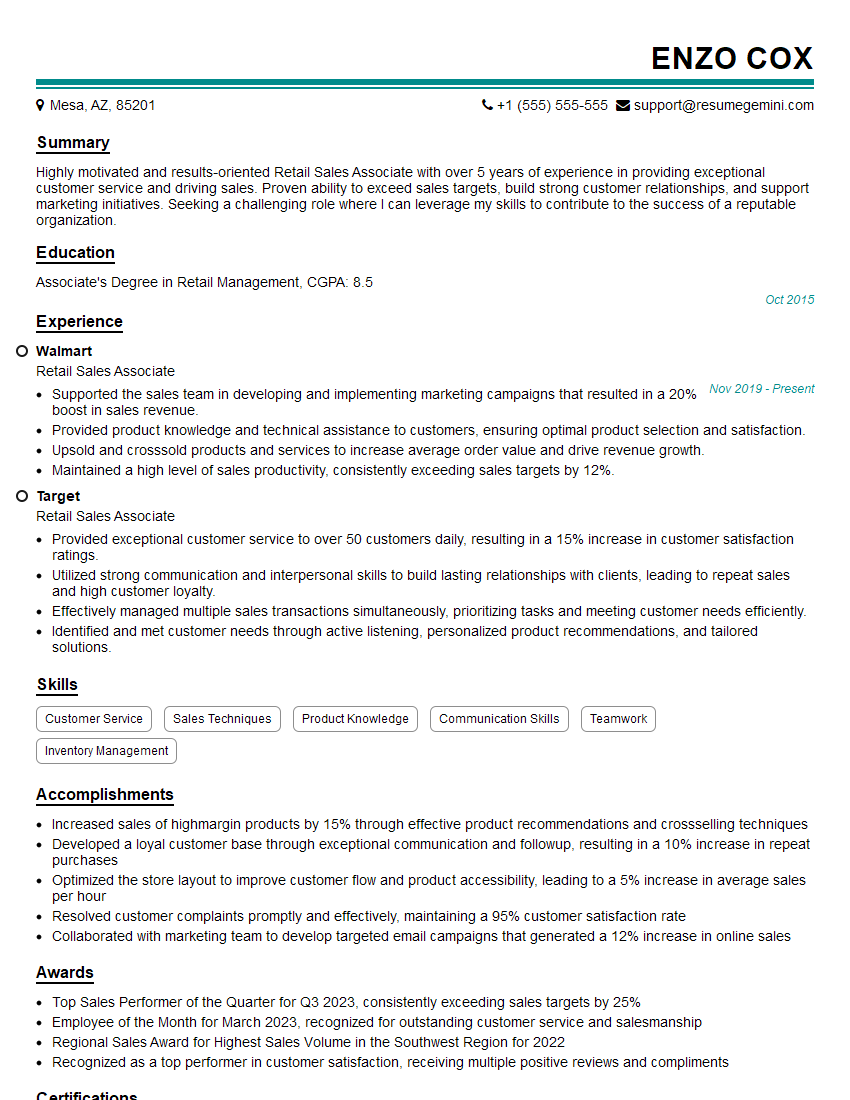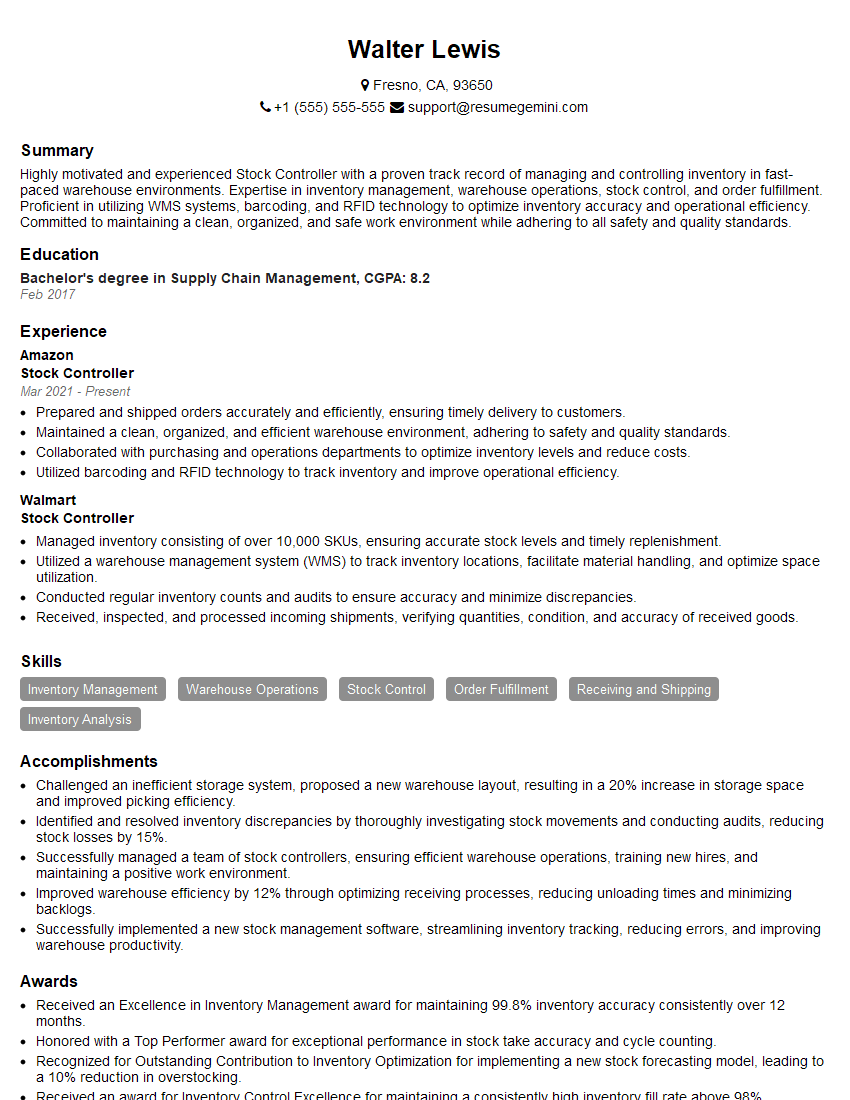Cracking a skill-specific interview, like one for Computer Literacy (POS systems, inventory management software), requires understanding the nuances of the role. In this blog, we present the questions you’re most likely to encounter, along with insights into how to answer them effectively. Let’s ensure you’re ready to make a strong impression.
Questions Asked in Computer Literacy (POS systems, inventory management software) Interview
Q 1. Describe your experience with different POS systems (e.g., Square, Shopify POS, Lightspeed).
My experience with POS systems spans several platforms, including Square, Shopify POS, and Lightspeed. Each offers a unique set of features and caters to different business needs. For instance, Square is known for its user-friendly interface and ease of setup, making it ideal for smaller businesses or startups. I’ve used Square to manage sales, process payments, and track basic inventory for a small coffee shop. Shopify POS, on the other hand, integrates seamlessly with Shopify’s e-commerce platform, offering a robust solution for businesses with both online and brick-and-mortar operations. I implemented Shopify POS for a clothing boutique, managing inventory across multiple locations and integrating online and in-store sales data. Finally, Lightspeed is a more comprehensive system suitable for larger enterprises, offering advanced features like employee management and detailed reporting capabilities. I worked with Lightspeed at a restaurant chain, where its robust reporting helped us optimize staffing levels and menu offerings based on sales data analysis.
Q 2. How familiar are you with inventory management software (e.g., Fishbowl, Cin7, NetSuite)?
My familiarity with inventory management software extends to systems like Fishbowl, Cin7, and NetSuite. These systems offer varying levels of sophistication and scalability. Fishbowl, for example, is a strong option for small to medium-sized businesses that need precise inventory tracking and manufacturing capabilities. I used Fishbowl to manage inventory for a small-batch artisanal soap maker, effectively tracking raw materials and finished goods. Cin7 is particularly well-suited for businesses with multiple sales channels, offering strong integration with e-commerce platforms and marketplaces. I helped a multi-channel retailer implement Cin7, improving their order fulfillment and reducing stockouts. NetSuite, a comprehensive ERP system, provides a complete suite of business management tools, including inventory management, for larger and more complex businesses. I’ve consulted with businesses utilizing NetSuite, focusing on optimizing their inventory processes and improving forecasting accuracy.
Q 3. Explain the process of reconciling POS data with inventory records.
Reconciling POS data with inventory records is crucial for maintaining accurate stock levels and preventing discrepancies. The process typically involves regularly exporting sales data from the POS system and importing it into the inventory management system. This data, usually containing information like product ID, quantity sold, and transaction date, is then compared with the existing inventory records. Any differences need to be investigated and corrected. For example, if the POS system shows 10 units of a particular item sold, but the inventory system only reflects 8 units sold, an investigation is needed to identify the cause of the discrepancy. This could be due to data entry errors, theft, or damaged goods. Automated reconciliation tools, available in many modern inventory systems, significantly streamline this process by automatically comparing and flagging discrepancies.
Q 4. How do you handle discrepancies between physical inventory and system inventory?
Discrepancies between physical inventory and system inventory are common and require a systematic approach to resolve. The first step is to conduct a thorough physical count to verify the actual stock levels. Then, this physical count is compared to the system inventory. Differences are investigated using root cause analysis. Possible causes include data entry errors (manual or automated), theft, damage, spoilage (for perishable goods), or inaccurate initial counts. Once the cause is identified, corrective actions are implemented, which might involve adjusting inventory records, implementing stricter security measures, improving data entry procedures, or adjusting forecasting models. For example, if consistent discrepancies show up in a specific product line, it might necessitate improving the accuracy of scanning processes or implementing better security protocols to deter theft.
Q 5. What are the common challenges in managing inventory, and how have you addressed them?
Common inventory management challenges include inaccurate forecasting, stockouts, overstocking, and inefficient processes. I’ve addressed these challenges by implementing various strategies. Inaccurate forecasting was improved using historical sales data analysis and incorporating seasonal trends into forecasting models. Stockouts were reduced by improving demand forecasting and implementing a robust safety stock management system. Overstocking was addressed through optimized ordering processes and improved communication with suppliers. Inefficient processes were streamlined using automation tools and implementing best practices like cycle counting and FIFO (First-In, First-Out) inventory management.
Q 6. Describe your experience with cycle counting and its importance.
Cycle counting is a crucial inventory management technique that involves regularly counting a small portion of your inventory rather than conducting a full physical inventory count all at once. This approach significantly reduces downtime and improves accuracy. Instead of a complete inventory count once or twice a year, a cycle count might involve counting a specific section of the warehouse or a certain category of products each week or month. The frequency and items counted are based on factors such as product value, demand, and turnover rate. The data from cycle counts is continuously updated in the inventory system, providing a more accurate real-time view of inventory levels. This method proved invaluable at a retail store where we reduced stock discrepancies by 40% within six months of implementing a robust cycle counting system.
Q 7. How do you use data from POS and inventory systems to make business decisions?
Data from POS and inventory systems provides invaluable insights for business decision-making. Analyzing sales data from the POS system can reveal popular products, slow-moving items, and seasonal trends. This information can inform purchasing decisions, pricing strategies, and marketing campaigns. Combining POS data with inventory data allows for accurate calculation of key performance indicators (KPIs) like inventory turnover rate, gross profit margin, and stockout frequency. For instance, I used this combined data to identify a slow-moving product line and, in collaboration with the marketing team, developed a successful promotional campaign that significantly increased its sales. Analyzing inventory levels and sales data also helps in optimizing storage space and logistics, minimizing warehousing costs.
Q 8. What metrics do you track to assess the efficiency of inventory management?
Assessing the efficiency of inventory management involves tracking key metrics that reveal how well your processes are performing. These metrics provide insights into areas for improvement and help optimize your inventory levels.
- Inventory Turnover Rate: This metric shows how many times your inventory is sold and replaced over a period (e.g., annually). A higher turnover rate generally indicates efficient inventory management, but an excessively high rate might signify understocking. The formula is Cost of Goods Sold / Average Inventory.
- Carrying Costs: This includes all expenses associated with holding inventory, such as storage, insurance, taxes, and obsolescence. Keeping carrying costs low is crucial for profitability. We’d track this as a percentage of total inventory value.
- Stockout Rate: This is the percentage of times an item is out of stock when a customer wants to purchase it. High stockout rates lead to lost sales and dissatisfied customers. We’d monitor this per product and product category.
- Fill Rate: This measures the percentage of customer demand met from available stock. A high fill rate demonstrates effective inventory planning and prevents stockouts. Again, monitoring at the individual product level is beneficial.
- Inventory Accuracy: This assesses how well your physical inventory matches your recorded inventory levels. Discrepancies indicate errors in stock taking or data entry, leading to inaccuracies in sales forecasting and planning. Regular cycle counts help maintain accuracy.
For example, imagine a retail store experiencing a high stockout rate for a popular item. Analyzing this metric helps pinpoint the root cause—perhaps the forecasting model is inaccurate or the reorder point is too low. Adjusting the reorder point and improving forecasting can increase the fill rate and reduce lost sales.
Q 9. Explain your understanding of different inventory valuation methods (FIFO, LIFO, weighted average).
Inventory valuation methods determine the cost of goods sold (COGS) and the value of ending inventory. Different methods impact financial statements and profitability calculations. Choosing the right method depends on the business’s specific circumstances and industry regulations.
- FIFO (First-In, First-Out): Assumes the oldest items in inventory are sold first. This method is often preferred as it results in a more accurate representation of the cost of goods sold, especially during periods of inflation, as the older, likely cheaper, inventory is reflected in the COGS.
- LIFO (Last-In, First-Out): Assumes the newest items are sold first. This method is less common (prohibited under IFRS) but is beneficial during periods of inflation as it reduces reported income and therefore tax liability (by reflecting current, higher prices in COGS). It can also more accurately reflect the actual flow of goods in some specific industries.
- Weighted Average Cost: Calculates the average cost of all units available for sale during a period. This method simplifies inventory valuation, especially when dealing with numerous purchases at varying prices. It’s calculated by dividing the total cost of goods available for sale by the total number of units available for sale.
Example: Imagine a business purchased 10 units at $10 each and later 20 units at $12 each. FIFO would cost the first 10 units at $10 and the next 10 sold at $12; LIFO would cost the first 10 units at $12 and the next 10 at $10; and the weighted average would be (($10*10) + ($12*20)) / 30 = $11.33 per unit.
Q 10. How do you ensure data accuracy in POS and inventory systems?
Data accuracy is paramount in POS and inventory systems. Inaccurate data leads to incorrect financial reporting, poor inventory management, and dissatisfied customers. Here’s how I ensure data accuracy:
- Regular Data Reconciliation: Periodically compare data from the POS system with physical inventory counts. Identify and investigate any discrepancies. This could involve cycle counting, where smaller portions of inventory are counted frequently, instead of a full count.
- Data Validation Rules: Implement data entry rules in the system to prevent incorrect entries. This might include range checks (e.g., ensuring prices are within a certain range), data type validation (e.g., preventing text in numeric fields), and mandatory fields.
- Automated Data Entry: Where possible, use automated systems to reduce manual data entry errors. Barcodes and RFID technology can significantly improve accuracy. For example, using a scanner to enter product information reduces the chance of typos.
- Employee Training: Train employees thoroughly on proper data entry procedures and system usage. Clearly defined processes and regular refresher courses minimize errors.
- Regular System Maintenance: Regularly back up data and run system checks to identify and address potential issues before they impact data integrity.
For instance, if a physical count reveals a discrepancy with the system’s recorded inventory, we’d investigate potential causes such as theft, damage, or data entry errors. Resolving these discrepancies is key to maintaining data accuracy.
Q 11. What is your experience with data entry and maintaining data integrity?
I have extensive experience in data entry and maintaining data integrity. My approach focuses on accuracy, efficiency, and consistency.
- Attention to Detail: I meticulously review all data entered to ensure accuracy and consistency. I understand the importance of double-checking entries and using standardized formats.
- Data Validation: I employ data validation techniques, such as cross-referencing data from multiple sources and performing plausibility checks, to ensure data integrity.
- Error Correction Procedures: I have established procedures for identifying, documenting, and correcting data entry errors. This involves documenting the error, its source, and the corrective action taken.
- Data Backup and Recovery: I regularly back up data to prevent data loss. I also have experience with data recovery procedures to restore data in case of system failures.
- Software Proficiency: I am proficient in various data entry software, including spreadsheet programs (Excel, Google Sheets) and database management systems (SQL).
In a previous role, I was responsible for entering sales data from multiple retail locations into a centralized database. Implementing data validation checks and regular data reconciliation significantly reduced errors and improved the overall accuracy of the data.
Q 12. How would you handle a system crash during a peak sales period?
A system crash during a peak sales period is a critical situation requiring immediate action. My response would prioritize minimizing disruption and data loss.
- Activate Backup Systems: Immediately switch to a backup POS system or manual processes (if available) to continue serving customers. This might involve using a portable device or a simple pen-and-paper system for temporary transactions.
- Data Recovery: Begin the process of recovering data from backups as soon as possible. Prioritize recovering sales transactions to avoid discrepancies and ensure accurate financial reporting.
- Customer Communication: Inform customers of the temporary system issue and apologize for any inconvenience. Explain the steps being taken to resolve the problem. Transparency is key to maintaining customer trust.
- Identify Root Cause: Once the system is back online, thoroughly investigate the root cause of the crash. This might involve checking server logs, system updates, or network issues to prevent future occurrences.
- System Maintenance: Perform necessary system maintenance and updates to enhance system stability and reliability. This includes regular backups and implementing disaster recovery plans.
For instance, if the POS system crashed due to a network outage, I would switch to a backup system and notify the internet service provider immediately. Once the network is restored, I’d review the sales transactions recorded offline to ensure they were properly entered into the main system.
Q 13. Describe your troubleshooting experience with POS system errors.
Troubleshooting POS system errors requires a systematic and logical approach. My experience encompasses various error types and resolutions.
- Identify the Error: First, accurately identify the error message or symptom. Note the specific circumstances under which the error occurs, and collect any error logs or relevant information.
- Check Basic Connections: For hardware issues, ensure all connections are secure and power is functioning correctly. This might involve checking cables, network connections, and printer connections.
- Software Updates: Check for software updates and install them if necessary. Outdated software can lead to bugs and compatibility problems.
- Restart Devices: Try restarting the POS terminal, printer, and other relevant devices. A simple restart often resolves temporary software glitches.
- Check Network Connectivity: Confirm the POS system has a stable network connection. Network problems can cause various errors, from slow processing to complete system failure.
- Consult Documentation and Support: If the problem persists, consult the POS system’s documentation or contact technical support. They can provide guidance on more advanced troubleshooting steps.
I recall an instance where a POS system was repeatedly crashing due to a corrupted database file. After trying several basic troubleshooting steps, I identified the corrupted file through system logs and restored it from a recent backup, resolving the issue.
Q 14. How do you handle customer inquiries related to POS system issues?
Handling customer inquiries regarding POS system issues requires professionalism, patience, and effective communication.
- Active Listening: Listen carefully to the customer’s concerns and understand the problem fully before attempting to provide a solution.
- Empathy and Apology: Acknowledge the customer’s frustration and apologize for any inconvenience caused by the POS system issue.
- Clear and Concise Explanations: Explain the issue in simple, non-technical terms that the customer can understand. Avoid jargon.
- Problem Solving: Attempt to resolve the issue promptly. If a solution is not immediately apparent, offer to escalate the problem to a technical support team.
- Follow Up: Follow up with the customer after the issue is resolved to ensure their satisfaction. A timely resolution and follow-up demonstrate a commitment to customer service.
In one instance, a customer was unable to complete a transaction due to a network connectivity problem. After confirming the network issue, I reassured them that we were working on resolving the problem and offered alternative payment options. I then followed up via email to ensure their transaction was eventually completed successfully.
Q 15. What experience do you have with reporting and analytics within POS and inventory systems?
My experience with reporting and analytics in POS and inventory systems is extensive. I’ve worked with various systems, from simple spreadsheet-based reporting to sophisticated business intelligence (BI) tools integrated directly with POS and inventory software. I’m proficient in extracting key performance indicators (KPIs) such as sales trends, best-selling items, inventory turnover rates, and profit margins.
For example, in my previous role, I used a BI tool to analyze sales data from our POS system, identifying a seasonal slump in sales of a specific product line. This allowed us to proactively adjust our marketing strategy and inventory levels, preventing significant losses. I can also create custom reports to address specific business needs, for example, tracking employee performance based on sales figures or identifying slow-moving inventory items. I’m comfortable working with various data visualization techniques to present complex data clearly and concisely to stakeholders.
I am also familiar with using reporting features to identify areas for improvement such as low stock alerts, potential stock discrepancies and forecasting future needs. I understand the value of accurate and timely reporting for informed decision making.
Career Expert Tips:
- Ace those interviews! Prepare effectively by reviewing the Top 50 Most Common Interview Questions on ResumeGemini.
- Navigate your job search with confidence! Explore a wide range of Career Tips on ResumeGemini. Learn about common challenges and recommendations to overcome them.
- Craft the perfect resume! Master the Art of Resume Writing with ResumeGemini’s guide. Showcase your unique qualifications and achievements effectively.
- Don’t miss out on holiday savings! Build your dream resume with ResumeGemini’s ATS optimized templates.
Q 16. How familiar are you with barcode scanning and RFID technology?
I’m highly familiar with both barcode scanning and RFID (Radio-Frequency Identification) technologies. Barcode scanning is a foundational technology in most POS systems, providing a fast and efficient way to process transactions. I have experience troubleshooting common issues like scanner malfunctions and barcode errors.
RFID technology offers a more advanced approach, allowing for automated inventory tracking and management. This is particularly useful for high-volume or high-value items where manual tracking is impractical or prone to error. I have experience implementing and managing RFID systems in warehouse environments and I understand the benefits of real-time inventory visibility and reduced shrinkage. Understanding the differences between these technologies allows me to recommend the appropriate technology based on a client’s specific needs and resources.
Q 17. Explain your understanding of the relationship between sales data and inventory levels.
Sales data and inventory levels are inextricably linked. Sales data directly impacts inventory levels, indicating which items are selling well and which are stagnating. Conversely, inventory levels influence sales; stockouts lead to lost sales opportunities, while overstocking ties up capital and increases storage costs.
Imagine a scenario where your sales data shows a consistent increase in demand for a particular product. This signals the need to increase inventory levels to meet this demand and prevent stockouts. Conversely, if sales data reveals slow-moving inventory, this signifies a need to review pricing strategies, marketing campaigns, or potentially consider clearing out excess stock. The goal is to maintain a healthy balance, ensuring sufficient inventory to meet customer demand without excessive overstocking. This relationship is crucial for effective inventory management and maximizing profitability.
Q 18. How would you improve the efficiency of a current POS or inventory management system?
Improving the efficiency of a POS or inventory management system requires a multifaceted approach. It often begins with a thorough assessment of the current system’s strengths and weaknesses. Key areas to focus on include:
- Process Optimization: Streamlining workflows to minimize redundant steps. For example, integrating the POS system with other business systems, like accounting software, can automate data entry and reduce errors.
- Technology Upgrades: Implementing newer technologies like cloud-based solutions or RFID tags to improve speed, accuracy, and accessibility of information.
- User Training: Ensuring that all staff are adequately trained on the system to maximize its capabilities and avoid user errors.
- Data Analytics: Implementing robust reporting and analytics capabilities to identify areas for improvement, such as slow-moving inventory or underperforming products.
- Integration with other systems: Seamless integration with accounting, CRM, and e-commerce platforms will ensure a complete and accurate view of the business.
For example, a common inefficiency is manual data entry. Transitioning to a system with automated data capture through barcode scanning or RFID can significantly reduce time spent on this task and improve accuracy. Implementing reporting features that automatically generate sales and inventory reports eliminates the time spent on generating them manually.
Q 19. Describe your experience with implementing new POS or inventory management software.
I have extensive experience implementing new POS and inventory management software. This involves a comprehensive process starting with needs assessment, vendor selection, system configuration, data migration, user training, and post-implementation support.
In a recent project, I led the implementation of a new cloud-based POS system for a retail chain. This involved migrating data from their legacy system, customizing the new system to meet their specific requirements, and providing training to over 100 staff members. We used a phased rollout approach, implementing the system in one store at a time to minimize disruption and allow for adjustments based on feedback. Post-implementation, we monitored system performance and provided ongoing support to address any issues. Successful implementation hinges on careful planning, strong communication, and effective project management.
Q 20. What are the key features you look for in a POS or inventory management system?
When evaluating POS and inventory management systems, I focus on several key features:
- Scalability: The system should be able to adapt to the business’s growth and changing needs.
- User-friendliness: The system should be intuitive and easy for staff to use, minimizing training time and errors.
- Reporting and Analytics: The system should provide comprehensive reporting and analytics capabilities to help make informed business decisions.
- Integration Capabilities: The system should be able to integrate with other business systems, such as accounting software and e-commerce platforms.
- Security: The system should have robust security measures to protect sensitive data.
- Real-time data: Access to real-time data on sales, inventory and other KPI’s is critical for informed decision making.
- Customer support: Access to comprehensive customer support and documentation is also very important.
It’s also essential to consider the vendor’s reputation, their track record, and their level of customer support.
Q 21. How do you stay updated on the latest POS and inventory management software trends?
Staying updated on the latest trends in POS and inventory management software is crucial for remaining competitive. I utilize several methods to achieve this:
- Industry Publications and Websites: I regularly read industry publications, blogs, and websites focused on retail technology and software.
- Trade Shows and Conferences: Attending industry trade shows and conferences allows me to see the latest products and network with other professionals.
- Vendor Websites and Webinars: I monitor the websites of leading POS and inventory management software vendors for updates and new features.
- Professional Networking: I actively participate in professional organizations and online communities to share knowledge and stay informed.
This continuous learning process ensures I’m aware of the latest innovations, best practices, and emerging technologies in this dynamic field.
Q 22. Explain your experience with integrating POS systems with other business applications (e.g., accounting software).
Integrating POS systems with other business applications like accounting software is crucial for streamlining operations and gaining a holistic view of business performance. This integration typically involves data exchange, allowing for automated updates across different systems. For example, sales data from the POS system can be automatically transferred to the accounting software to update sales figures, inventory levels, and generate reports. This eliminates manual data entry, reducing errors and saving significant time.
In my previous role, I integrated a Square POS system with QuickBooks Online. We used Square’s API to create a custom integration that automatically synced sales transactions, including item details, payment methods, and taxes. This ensured that our accounting records were always up-to-date and accurate, facilitating faster financial reporting and analysis. Another example involved using a custom-built middleware solution to connect a legacy POS system with a more modern ERP system. This involved careful data mapping and transformation to ensure compatibility between the two systems.
Successful integration requires understanding the capabilities of both systems, API documentation, and potentially custom development or the use of third-party integration tools. It’s important to thoroughly test the integration to ensure data accuracy and prevent data loss.
Q 23. How do you ensure data security within POS and inventory management systems?
Data security in POS and inventory management systems is paramount. Breaches can lead to financial losses, reputational damage, and legal repercussions. A multi-layered approach is essential.
- Access Control: Implementing robust user roles and permissions ensures that only authorized personnel have access to sensitive data. This includes restricting access to sensitive areas like financial reports or employee records.
- Data Encryption: Both data at rest (stored on databases or servers) and data in transit (transmitted over networks) should be encrypted using strong encryption algorithms. This protects data from unauthorized access even if a system is compromised.
- Regular Software Updates: Keeping software updated patches security vulnerabilities that hackers could exploit. This includes the POS system itself, the operating system, and any connected devices.
- Firewall and Intrusion Detection Systems: These security measures protect the network from unauthorized access and malicious activity. They act as a barrier against external threats.
- Employee Training: Employees need training on security best practices, including password management, phishing awareness, and recognizing suspicious activity.
- Regular Security Audits: Conducting periodic audits helps to identify vulnerabilities and ensure that security measures are effective. This can involve penetration testing to simulate real-world attacks.
Think of it like a bank vault: multiple locks, strong construction, and security personnel all contribute to keeping the valuables safe.
Q 24. What is your experience with using mobile POS systems?
Mobile POS systems offer increased flexibility and mobility, allowing transactions to be processed anywhere within the store or even outside. I have extensive experience using various mobile POS solutions, including Square, Shopify POS, and Toast POS. These systems typically utilize tablets or smartphones, offering features like inventory management, customer relationship management (CRM) integration, and payment processing capabilities.
In one project, we implemented a mobile POS solution for a large retail chain. This allowed their staff to assist customers anywhere in the store, improving customer service and reducing checkout times. The mobility also allowed for easier processing of transactions during events or promotions held outside of the main store.
The key benefits of mobile POS include improved customer experience, increased efficiency, and enhanced data collection capabilities. However, challenges include ensuring reliable connectivity, managing battery life, and safeguarding data security on mobile devices.
Q 25. How do you prioritize tasks when managing multiple POS and inventory functions?
Prioritizing tasks when managing multiple POS and inventory functions requires a structured approach. I typically use a combination of techniques:
- Urgency and Importance Matrix (Eisenhower Matrix): This categorizes tasks based on urgency and importance, allowing me to focus on the most critical items first.
- Task Management Software: Tools like Asana or Trello help me track tasks, deadlines, and progress. This provides a clear overview of all ongoing activities.
- Prioritization Based on Business Impact: I prioritize tasks that have the greatest impact on business goals, such as resolving critical system issues or addressing inventory shortages that impact sales.
- Regular Review and Adjustment: I regularly review my task list and adjust priorities as needed, considering emerging issues and changing business requirements.
For example, a critical system error affecting sales would take immediate priority over a less urgent task like updating inventory reports. By using a systematic approach, I ensure that the most important tasks are completed efficiently and effectively.
Q 26. Describe a situation where you had to solve a problem related to POS or inventory systems.
In a previous role, we experienced a significant discrepancy in our inventory records. After investigating, we found that a data entry error in the POS system was causing incorrect inventory levels to be recorded. This error was leading to stockouts of popular items and overstocking of less popular ones.
My approach to resolving this involved the following steps:
- Identify the root cause: We meticulously reviewed transaction logs and compared them to physical inventory counts. This revealed the data entry error in the POS system.
- Data Correction: We implemented a process to correct the incorrect data entries in the POS system. This involved creating a script to automatically adjust the affected inventory records based on our physical inventory counts.
- Preventative Measures: To prevent this from happening again, we implemented stricter data validation rules within the POS system. This ensured that data entry errors are caught immediately.
- Employee Training: We provided additional training to staff on accurate data entry procedures. This included emphasizing the importance of double-checking entries.
This situation highlighted the importance of regular inventory checks, robust data validation, and thorough employee training. By addressing the root cause and implementing preventive measures, we successfully resolved the issue and improved the accuracy of our inventory management.
Q 27. What are the limitations of current POS and inventory management systems?
Current POS and inventory management systems, while advanced, have limitations:
- Integration Challenges: Integrating different systems can be complex and costly, requiring significant time and resources. Incompatibilities between systems can also pose challenges.
- Cost: High initial investment costs and ongoing maintenance fees can be a barrier for small businesses. This includes software licensing, hardware upgrades, and potential customization costs.
- Scalability Issues: Some systems may not scale well as a business grows. This can lead to performance issues or require costly upgrades as the volume of transactions and data increases.
- Data Migration: Migrating data from legacy systems to new platforms can be challenging and time-consuming. This requires careful planning and execution to minimize disruption and data loss.
- Lack of Customization: Some systems offer limited customization options, making it difficult to tailor them to specific business needs.
Addressing these limitations often involves choosing the right system based on business size and needs, investing in robust integration solutions, and planning for future scalability.
Q 28. How can technology improve the accuracy and efficiency of inventory management?
Technology significantly improves the accuracy and efficiency of inventory management through various means:
- Barcode and RFID Scanning: Using barcode or RFID scanners for tracking inventory eliminates manual data entry, reducing errors and improving speed. This enables real-time tracking of inventory levels.
- Inventory Management Software: Sophisticated software provides features like automated reordering, demand forecasting, and real-time inventory tracking. This minimizes stockouts and overstocking.
- Cloud-Based Solutions: Cloud-based systems provide accessibility from anywhere with an internet connection, enhancing collaboration and real-time visibility of inventory levels across multiple locations.
- Data Analytics: Using data analytics to analyze sales patterns and inventory trends allows for better forecasting and optimization of inventory levels. This can lead to significant cost savings and increased profitability.
- Automated Ordering Systems: Connecting inventory management software directly with suppliers allows for automated reordering when stock levels fall below a certain threshold. This streamlines the procurement process and reduces manual intervention.
Imagine trying to manage inventory for a large supermarket without barcodes – it would be a logistical nightmare! Technology makes this process manageable and efficient.
Key Topics to Learn for Computer Literacy (POS systems, inventory management software) Interview
- Point of Sale (POS) Systems: Understanding different POS system functionalities (e.g., sales processing, payment processing, reporting), hardware components (e.g., barcode scanners, receipt printers), and common software features (e.g., customer relationship management (CRM) integration, employee management).
- Inventory Management Software: Familiarity with inventory tracking methods (e.g., FIFO, LIFO), understanding of inventory cycle counting, and experience with software features like stock alerts, order management, and demand forecasting. Practical application: Explain how you would use inventory data to optimize stock levels and minimize waste.
- Data Entry and Accuracy: Importance of accurate data entry in both POS and inventory systems, understanding the consequences of errors, and strategies for maintaining data integrity. Practical application: Describe your experience with handling large datasets and ensuring accuracy.
- Reporting and Analysis: Interpreting sales reports generated by POS systems and utilizing inventory data for analysis. Practical application: Explain how you would use sales data to identify trends or high-performing products. How would you use inventory data to identify slow-moving items or potential shortages?
- Troubleshooting and Problem Solving: Addressing common technical issues within POS and inventory systems. Practical application: Describe a situation where you encountered a technical problem and how you successfully resolved it.
- Software Specific Knowledge: While specific software names aren’t required, being familiar with common software types (e.g., cloud-based vs. on-premise systems) will greatly benefit your interview. Understanding the differences and advantages of each is crucial.
Next Steps
Mastering computer literacy in POS and inventory management systems is crucial for success in many roles, showcasing your efficiency and technical aptitude to potential employers. A strong understanding of these systems opens doors to a wide variety of opportunities within retail, hospitality, and logistics industries. To maximize your job prospects, focus on crafting an ATS-friendly resume that highlights your skills and experience effectively. ResumeGemini is a trusted resource that can help you build a professional and impactful resume, tailored to showcase your proficiency in POS and inventory management software. Examples of resumes tailored to this specific skillset are available to guide you. Invest the time in creating a strong application – it’s an investment in your career.
Explore more articles
Users Rating of Our Blogs
Share Your Experience
We value your feedback! Please rate our content and share your thoughts (optional).
What Readers Say About Our Blog
Hello,
We found issues with your domain’s email setup that may be sending your messages to spam or blocking them completely. InboxShield Mini shows you how to fix it in minutes — no tech skills required.
Scan your domain now for details: https://inboxshield-mini.com/
— Adam @ InboxShield Mini
Reply STOP to unsubscribe
Hi, are you owner of interviewgemini.com? What if I told you I could help you find extra time in your schedule, reconnect with leads you didn’t even realize you missed, and bring in more “I want to work with you” conversations, without increasing your ad spend or hiring a full-time employee?
All with a flexible, budget-friendly service that could easily pay for itself. Sounds good?
Would it be nice to jump on a quick 10-minute call so I can show you exactly how we make this work?
Best,
Hapei
Marketing Director
Hey, I know you’re the owner of interviewgemini.com. I’ll be quick.
Fundraising for your business is tough and time-consuming. We make it easier by guaranteeing two private investor meetings each month, for six months. No demos, no pitch events – just direct introductions to active investors matched to your startup.
If youR17;re raising, this could help you build real momentum. Want me to send more info?
Hi, I represent an SEO company that specialises in getting you AI citations and higher rankings on Google. I’d like to offer you a 100% free SEO audit for your website. Would you be interested?
Hi, I represent an SEO company that specialises in getting you AI citations and higher rankings on Google. I’d like to offer you a 100% free SEO audit for your website. Would you be interested?
good

